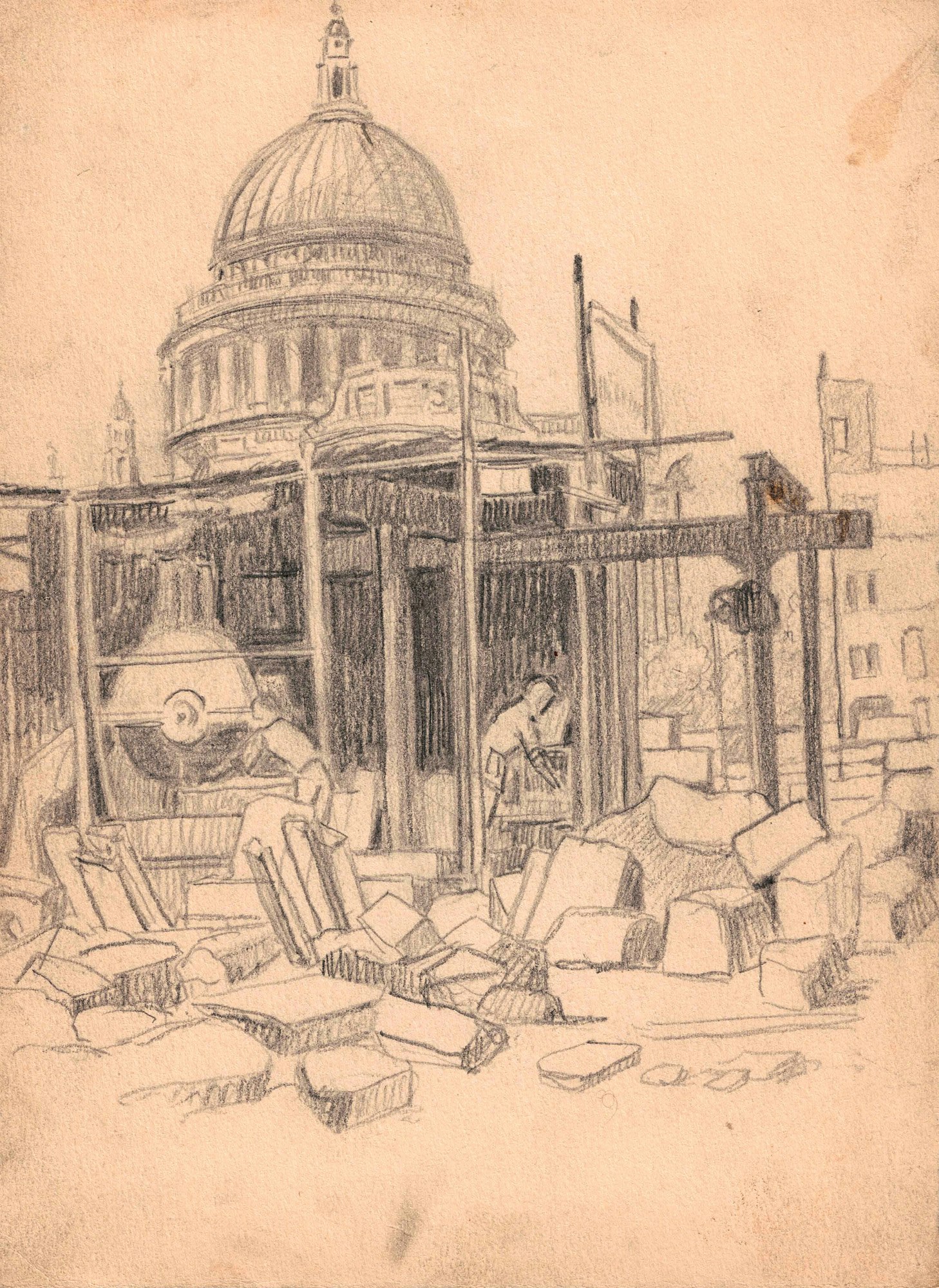This article is taken from the October 2024 issue of The Critic. To get the full magazine why not subscribe? Right now we’re offering five issues for just £10.
On Saturday, 7 September 1940 the first bomb of the Luftwaffe’s systematic blitz of London fell at 43 Southwark Park Road, SE16. It was a grocer’s shop. Twelve minutes later, the first military target was hit, an RAF timber shed in Catford. Fourteen minutes later the first London church affected by the blitz, St Cyprian’s in Brockley, was severely damaged.
Over the next 24 hours, 843 bombs fell on the capital, almost exclusively in the south and the east. This was the working-class 19th century London of the docks and of the cheap penny railway ticket, two-storey stock brick homes with dark-green-framed sash windows in streets whose names sang of Victorian imperial confidence: the RAF shed was on Sandhurst Road; St Cyprian’s was on Adelaide Avenue.

Over the next nine months, London was heavily bombed 71 times. On 16 April 1941, Christopher Wren’s St James’s Piccadilly was gutted. The diarist James Lees-Milne wrote:
The sky had the gun metal solidity of sky before a snow storm. Cinders showered upon our hair, faces and clothes … I was reminded of Pepys’s description of the Great Fire of London in 1666, “the most malicious bloody flame, not like the fine flame of an ordinary fire”.
By 1945, nearly 30,000 Londoners were dead and around 116,000 homes had been destroyed or irreparably damaged. “London,” wrote Elizabeth Bowen, “looks like the moon’s capital … shallow, cratered, extinct.”
What phoenix should emerge from the ashes? How should the future differ from the past?
Modernists had an answer. Funded by a car manufacturer in the 1920s, the Swiss-French architect Le Corbusier, the prophet of traffic-modernism, of man as machine-part and of the city as motorways and landing strips, had dreamt of demolishing central Paris and replacing it with fast roads and huge towers in sociologically segregated zones. As he explained, “the technocratic elite, the industrialists, financiers, engineers, and artists would be located in the city centre, whilst the workers would be removed to the fringes of the city”.
The architect and town planner Sir Patrick Abercrombie’s 1944 Greater London Plan attempted to put this dirigiste theory into practice. The men in Westminster, Whitehall and County Hall were mesmerised. Here surely was the future, all neatly printed and bound in one report.
London would be decentralised and sliced through to help the traffic. Five enormous ringways would encircle the city, linked by dozens of radials. Mile upon mile of the “drab and dreary” buildings in between would be cleaned away with half a million people compulsorily removed to new “satellite towns” or newly-zoned residential estates.
As always, the poor would have the least choice. 40 per cent of the East End population would be transported. A few historic villages, such as Kensington, would be allowed to remain. Everything else would have to go. How this could have been achieved without catastrophic urban destruction is impossible to comprehend.
❂
Ironically, conservationists tended to agree with the planners. In contrast to its continental cousins, the British conservation movement, influenced by John Ruskin and largely called into being by the superhuman energy of William Morris, was created more to oppose “restoration” than to encourage it. Its bogeyman was not the railway company slicing through the suburbs but the architect Sir George Gilbert Scott, whose “improvements” to mediaeval churches and “railway station gothic” Morris detested with demonic fury, describing Scott shortly after his death as “a happily dead dog”. Nothing was worse than faking the past, putting back what had been lost or scraping away the patina of age.

Thus in Britan — unlike continental Europe, where the argument for or against “recreation” of lost buildings and streets was more finely balanced — a uniquely broad alliance of planners, modernist architects and heritage aficionados all favoured the terra rasa approach to redevelopment, as implied by Raymond Myerscough-Walker’s poster of a huge neo-Georgian block behind a gutted St Bride’s.
But the future never did come, at least not completely. The London Plan’s unapologetic ambition meant that lack of funds in post-war Britain hampered progress. Dual carriageways were cut through at London Wall and on Upper and Lower Thames Street, but most of London remained imperfectly encircled.
Thousands of damaged but recuperable houses were pointlessly demolished, but thousands more were not. Many Londoners resisted being decanted. Community groups argued for the rehabilitation of their houses rather than their wholesale demolition. At a protest meeting, one statement summed up the mood: “You claim you’re bettering us but you’re not. You’re nicking space off us: you are going to give us less than we started with. It’s a bloody farce.”
Even when still freshly minted, many of the new multi-storey housing estates became hard to let. Families simply refused to move in. The Thamesmead Estate, completed in 1968, was only 40 per cent full by 1974. In Haringey, 55 per cent of housing applicants would not move to the Broadwater Farm Estate within five years of its completion in 1971.
This was all in the context of a London population that fell from 1939 until 1983. It did not again exceed its pre-war peak of 8.65 million until 2015. The population of the old inner London boroughs fell 67 per cent. The melancholy consequence was “planning blight”: acres of London zoned for comprehensive redevelopment left for years to “stand and rot” in the words of Colin Amery and Dan Cruickshank. Eric Huson’s images of London achingly conjure up the miserable emptiness of a de-industrialising London waiting for a future that had not yet come.
❂
Hardly surprisingly, by the 1960s councils such as Islington began to realise that it was both cheaper and much easier to repair and refit old houses than to rip everything down and start afresh. The same civilised approach was taken to most of Wren’s churches. Both St Bride’s and St James’s were lovingly restored and re-consecrated. The future had been postponed and would have to come another day.
Wandering around London today, evidence of the Blitz has largely vanished. The damaged buildings are long since demolished; the shrapnel scars cured; even the frequently loveless post-war rebuilding is now often being “regenerated” away. Some prominent buildings still carry their scars, as recent exquisitely detailed drawings by Minty Sainsbury of the V&A, Tate Britain and St Clement Danes bring into relief.

Just northwest of St Paul’s Cathedral is London’s second largest post-war development, the Barbican. Milton Court was the first section to be completed in 1959. Replaced by new buildings for the Guildhall School of Music and Drama in 2008, it was the first to disappear — a savage failure of “sustainable development” after less than 50 years.
By contrast, the streets and squares which escaped the Luftwaffe’s or the post-war town planners’ attention have the clearest future. How much of post-war London will join them and survive the next 50 years? Or the next 500?
Enjoying The Critic online? It's even better in print
Try five issues of Britain’s most civilised magazine for £10
Subscribe



